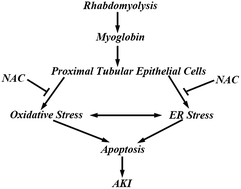Rhabdomyolysis induced AKI via the regulation of endoplasmic reticulum stress and oxidative stress in PTECs†
Abstract
Although rhabdomyolysis-associated acute kidney injury (AKI) is a life-threatening clinical condition that accounts for about 10–40% of AKI cases, the mechanism underlying rhabdomyolysis-associated AKI has not been fully understood. In an in vivo study on the use of antioxidant N-acetyl-L-cysteine (NAC) to block endoplasmic reticulum (ER) stress and oxidative stress, functional and histologic results showed more progressive renal damages and increased expressions of caspase-12, cleaved caspase-3, BAX, GRP78 and CHOP among the glycerol-treated littermates (50%, 10 mL kg−1, IM), compared with the control group. Serum levels of SOD and MDA levels decreased in the glycerol group, while the NAC pretreatment group exhibited partially reversed functional and histological changes. Moreover, in an in vitro study, cells apoptosis, levels of GRP78, CHOP, caspase-4, cleaved caspase-3, BAX and reactive oxygen species (ROS) expressions were found to increase in response to the myoglobin treatment (200 mM), highlighting the involvement of apoptosis of proximal tubule epithelial cells (PTECs) in the activation of ER stress and oxidative stress. Taken altogether, the results indicate that rhabdomyolysis-induced AKI may be due to activated ER stress and oxidative stress in PTECs.


 Please wait while we load your content...
Please wait while we load your content...